Index to Prague series
- Castles, Cathedrals, and Communists
- Old Town, New Town, and Revolution!
- A Millennium of Jewish Community
- Off the Beaten Track in Vyšehrad
With three days padded onto my Austria trip, I could take the train east for three hours to Budapest or north and west for five hours to Prague. As you may already know, Hungary is now governed by Viktor Orbán, whose right-wing populist government has undermined democratic norms in that nation. I decided to go to the Czech Republic, instead! My train ride there was perfectly lovely, cutting through mountain valleys laden with snow, with more arriving as I passed. The railway deserves its standing as a World Heritage Site!
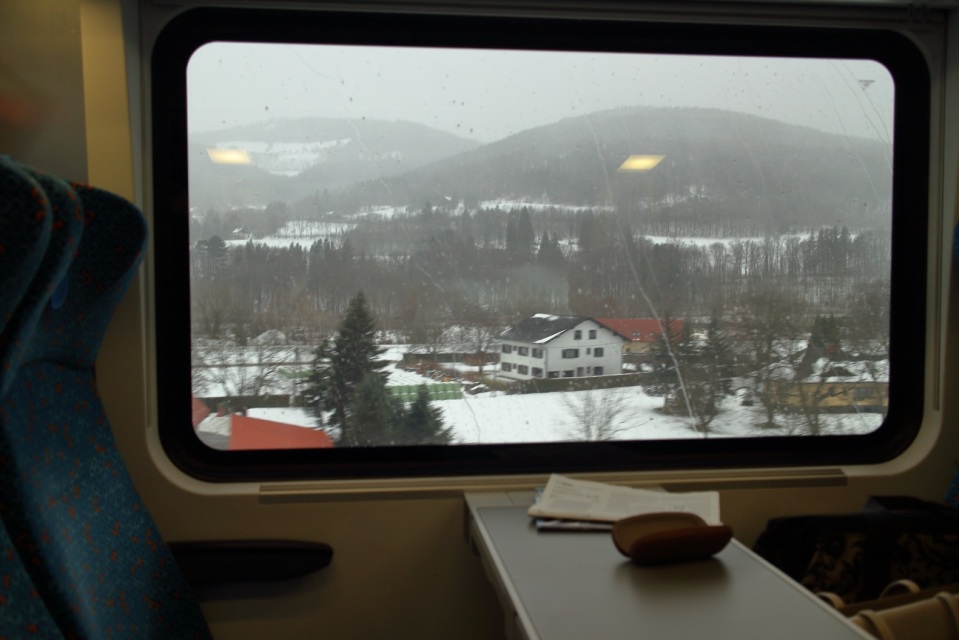
The train traveled at 60 kph through the mountains and then accelerated up to 160 kph in the plains. The train to Prague cost only 54 Euros!
For my four nights in Prague, I stayed at the Hotel Prague Star. Located in the New Town (Nové Město) area just five minutes’ walk from the National Museum, the hotel offered affordable rates. It shared a street with several night clubs of a shady nature (the type that spams the tourist district with images of under-dressed women with the word “censored” appearing in strategic locations). The flashing neon lights ensured I found the correct street when I slogged home after a long day of tourism.
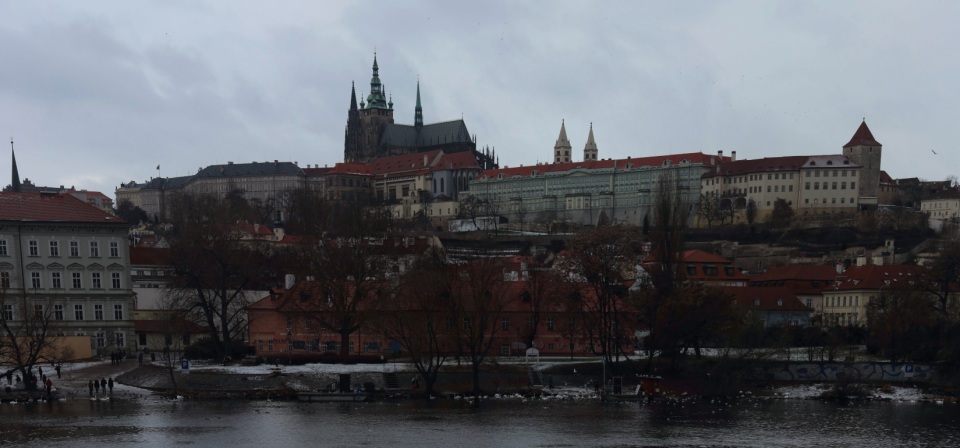
Prague Castle is massive, stretching the width of this panoramic photo (4 images combined with Hugin).
My first full day in Prague took me to the massive Prague Castle, perched atop a hill to the northwest of the Prague Old Town and across the Vltava River. The castle dates from 880, when it was constructed by the first historically attested Duke of Bohemia Bořivoj I, from the Přemyslid family. One of the first structures one sees when entering the castle is the magnificent basilica of St. Vitus.
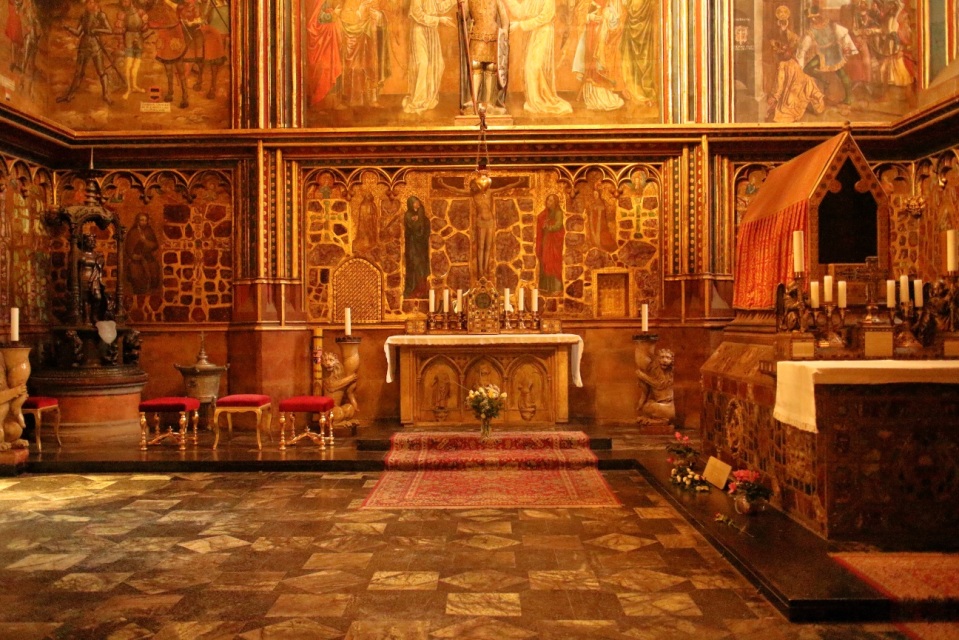
The box at the right contains a saint.
The castle contains the final resting place of multiple saints, but St. Vitus may be most known for its chapel commemorating the great-grandson of the castle builder: Saint Wenceslaus! As Duke of Bohemia from 921-935 (he began his reign at age 14), Wenceslaus controversially favored the adoption of Christianity in Bohemia. His younger brother conspired to assassinate him, driving a lance through the Duke in the killing blow. He then succeeded Wenceslaus as Boleslaus I the Cruel.
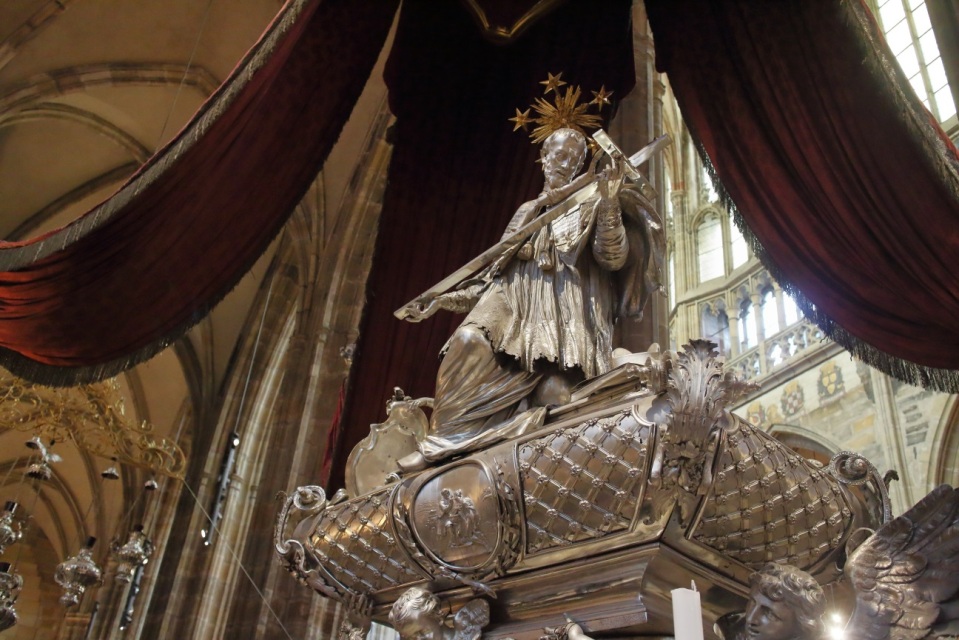
St. John of Nepomuk was important in establishing the seal of the confessional.
The most magnificent memorial in St. Vitus’ Cathedral is devoted to Saint John Nepomucene. As a vicar-general, he heard the confession of the queen. King Wenceslaus IV (who ruled several generations after Saint Wenceslaus) wanted to know what the queen had been confessing to her priest. The vicar-general was unwilling to divulge that information. He was subsequently tortured, and eventually the king drowned Saint John Nopmucene in the Vltava River. I was quite surprised to discover that the lineal descendant of one saint had martyred another!
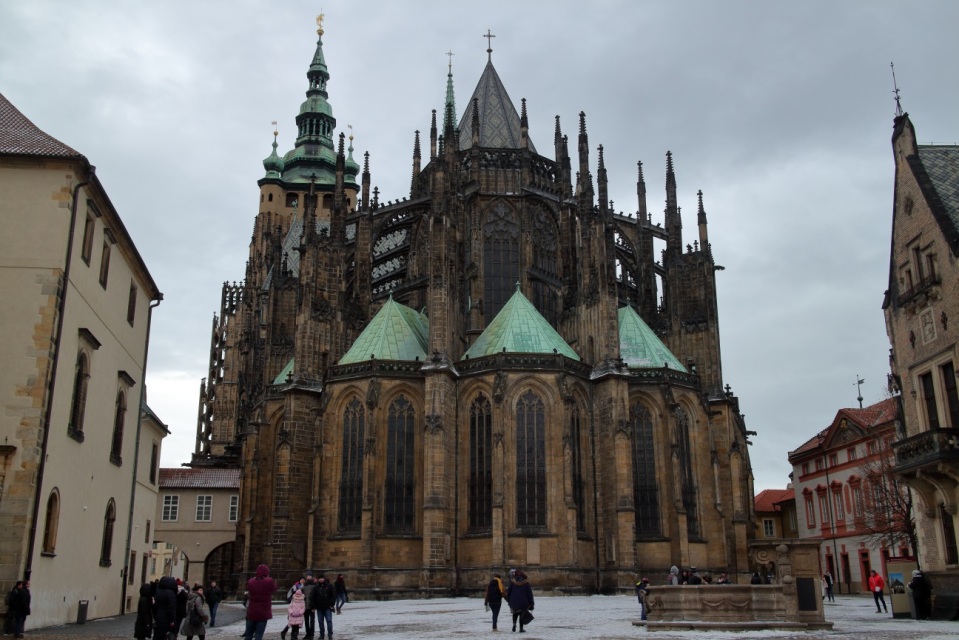
St. Vitus Cathedral was finally finished in 1929, 600 years after it was begun!
To visit Prague is to see the hand of Charles IV (1316-1378). His father headed the House of Luxembourg, and his mother was the last member of the House of Přemyslid. In 1346 and 1347, he inherited the county of Luxembourg, was elected king of Bohemia, and was elected king of the Romans (though it didn’t “take” until he was re-elected in 1349). By 1355 he was king of Italy and the Holy Roman Emperor. Ten years later, his coronation as King of Burgundy united the Holy Roman Empire under his leadership. Charles IV selected Prague as his capital, and he expanded the city to include the “New Town” (where my hotel was located) and founded what became Charles University. Because of Charles IV, one frequently learns that Prague buildings were first constructed in the 14th century.
I had opted for “Circuit A” tickets to the castle, which also included a tour of the oldest hall of the castle, a museum celebrating its long history, the Basilica of St. George, the Golden Lane, and the Powder Tower museum for the castle guard service. The Old Royal Palace was a bit confusing. The chamber, its chapel, and the stone steps that were made for horseback arrivals were largely empty, and few signs explained what I saw. It was clear, however, that the Palace had been remodeled so many times over the years that the structure was a bit of a pastiche of styles. I would love to have a photo of its beautifully decorated ceiling, but no photographs were allowed in the Old Royal Palace or in the castle museum.
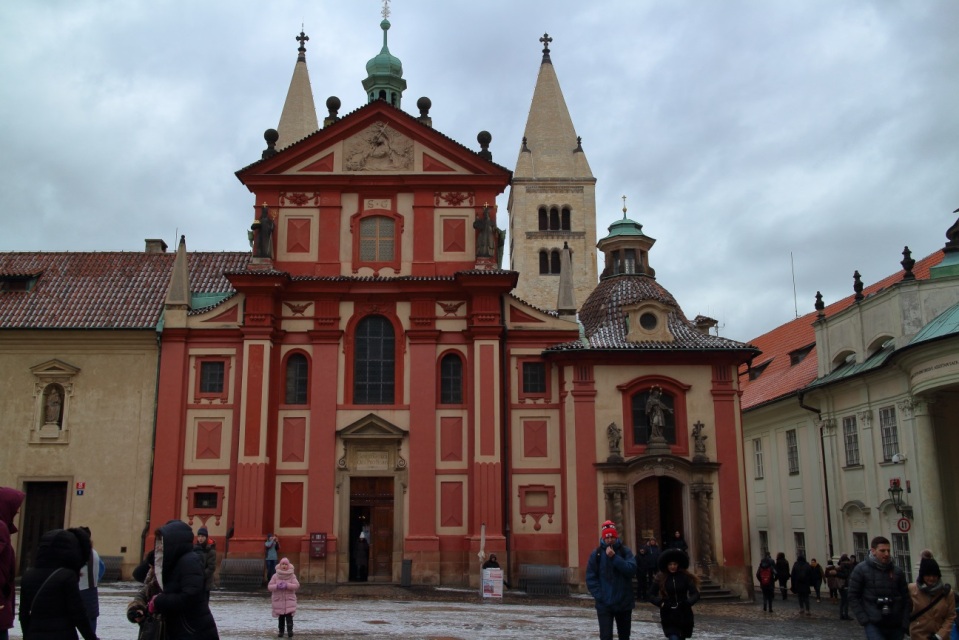
The Basilica of St. George sits directly behind St. Vitus.
The facade of the Basilica of St. George was probably its nicest aspect. The Romanesque church contributes the two towers that one can see to the right of the Gothic St. Vitus in the skyline panorama above. The walls are much thicker than one sees in Gothic cathedrals, and the windows are much smaller and higher up.
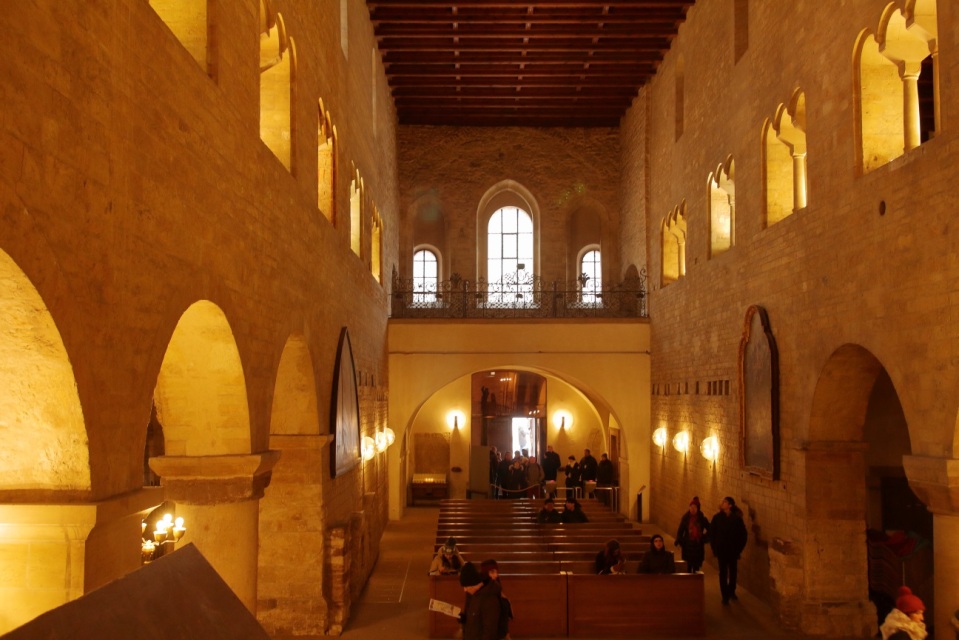
A church has stood here since 920.
The Golden Lane is down slope from the royal part of the castle. The small houses line the inner side of the outer wall, almost like the artisan homes that lined the walls of the Tower of London. Local legend has it that the most promising alchemists of the 16th century worked in this area. Today the buildings have been collected by a running hall on the upper floor, and galleries line the sides to sell replica weapons, showcase suits of armor, remind visitors of the horrors of medieval torture, or reveal updated uses of the buildings. For one, Franz Kafka kept residence here for two years to write in peace.
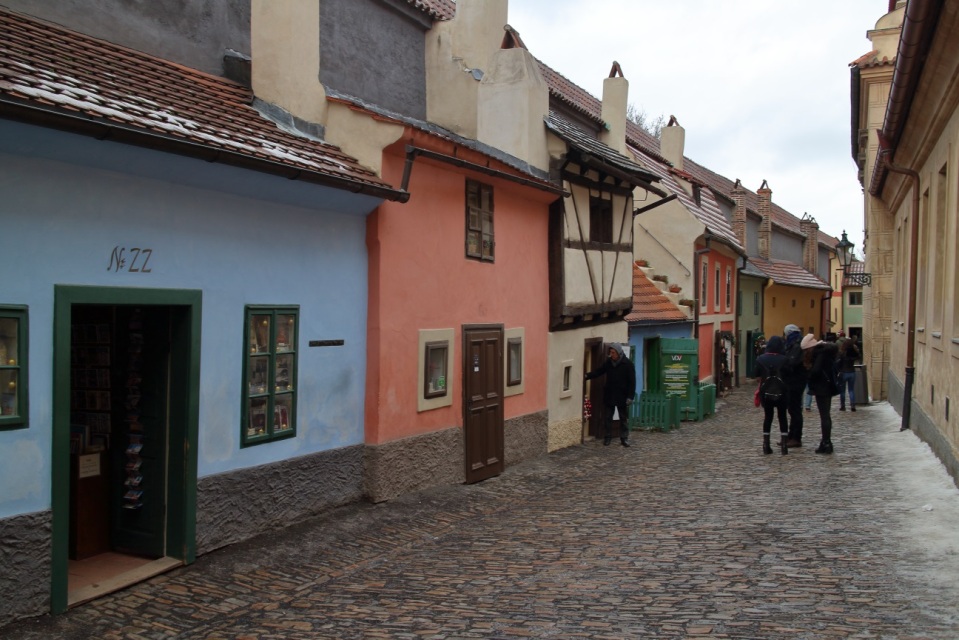
Housing a family in such a small dwelling would be a challenge!
I was delighted at the view from the eastern end of the castle, and yet I was ravenously hungry. I descended the hill and stopped at Tom’s Burger. That burger and fries entirely hit the spot! Based on a recommendation by my server, I tried the “Czech version of Coca-Cola,” called Kofola. I was smitten! The closest parallel in my experience is the amazing taste of sasparilla. For the remainder of my time in Prague, I sought out the beverage.
On my walk, the advertisements for the Museum of Communism had repeatedly caught my eye. My favorite was a teddy bear clutching an AK-47. Happily, the museum was quite easy to find, at the intersection where Wenceslaus Square touches the Old Town (above a McDonald’s actually). I appreciated their large Communist-era statues and could not resist a photo with that old scamp V.I. Lenin.
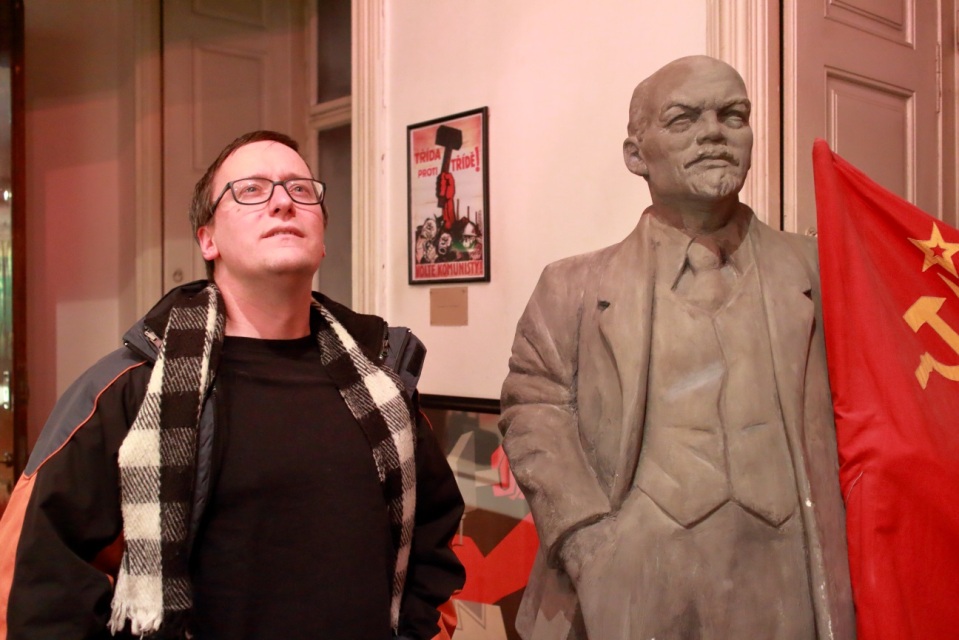
I think the scarf really complements this look.
The museum documents another statue on a scale that is hard to credit. Around 1950, the government of Czechoslovakia began construction of a sculpted group of people standing behind Joseph Stalin that soared almost 16 meters high. It was unveiled on May 1st, 1955 (the sculptor committed suicide the day before). On February 25, 1956, however, Khrushchev gave a key speech decrying Stalin’s “cult of personality” as incompatible with communism (Stalin had died in 1953). In the aftermath, monuments celebrating Stalin were considered distasteful. Only seven years after its construction, the Prague Stalin Memorial was blasted apart by 800 kg of explosives!
The movie room for the Museum of Communism was a useful overview of the resistance to communism in this country. The Prague Spring (1968) seemed to suggest that some freedoms could be possible in Czechoslovakia until a Soviet invasion ended those hopes. Civilian protests were broken up with considerable violence from the police and troops. The video showed a representative of the government being interviewed on state TV. He claimed that “mild means” were used to disperse the crowd. “They are our citizens, and we treat them as such.” The juxtaposition of onscreen violence with “mild means” was jarring. The video also introduced me to the Plastic People of the Universe, whose music exhibited much greater freedom than the official style of “Soviet Realism.” The group members were arrested in 1976. The artists of Charter 77 (including Vaclav Havel), however, generated some significant pressure for their release. The Charter 77 artists, of course, were under vigilant attention from the government thereafter. The fall of communism came rather suddenly to Czechoslovakia in the Velvet Revolution. As a 1989 saying had it, Communism took ten years to fall in Poland, ten months in Hungary, ten weeks in east Germany, and ten days in Czechoslovakia!
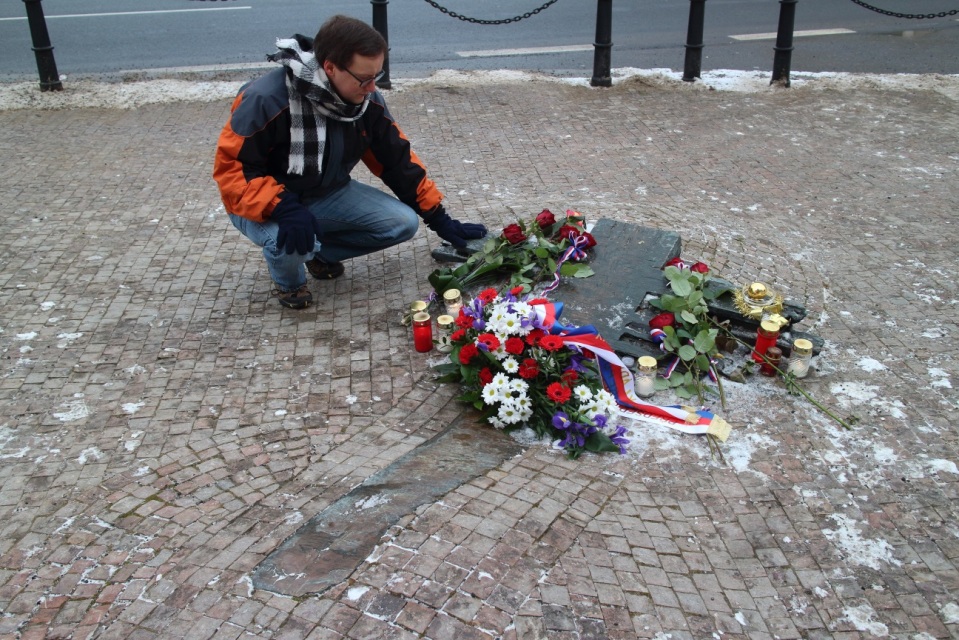
I visited the memorial of Jan Palach on the anniversary of his death.
On my final full day in Prague, I decided to follow a lead I had found during my visit to the Museum of Communism. I had read the story of Jan Palach, a young idealist who had become so distraught at the Soviet invasion of Prague in 1968 that he decided to burn himself to death at the head of Wenceslaus Square. The memorial to him is in two parts. A plaque below the equestrian statue of Wenceslaus I bears his name as well as that of Jan Zajíc, who chose the same death for himself a year later. Just outside the National Museum, a cross has been embedded in the pavement, with the surface rippled by several inches. I was surprised to discover that the cross was covered in flowers and lit candles. By happenstance, I had arrived at the cross on January 19th, the anniversary of Jan Palach’s death. I saw two delegations from government ministries arrive with fresh loads of flowers, and a gentleman took considerable pains, despite his limited English abilities, to convey to me that this memorial was one of special importance. I could only pause for several moments’ quiet at the memorial.

Alan and I are sitting here laughing over photo of you in scarf. You are SO silly!
LikeLiked by 1 person
I am so glad you like the image! I had worried that posing with Lenin might be in bad taste.
LikeLike
Pingback: Prague: Old Town, New Town, and Revolution! | Picking Up The Tabb
Pingback: Prague: off the beaten track in Vyšehrad | Picking Up The Tabb
Pingback: Prague: a millennium of Jewish community | Picking Up The Tabb
Pingback: The photographs of a life in motion | Picking Up The Tabb
Pingback: St. Petersburg: The docs on the Orthodox | Picking Up The Tabb